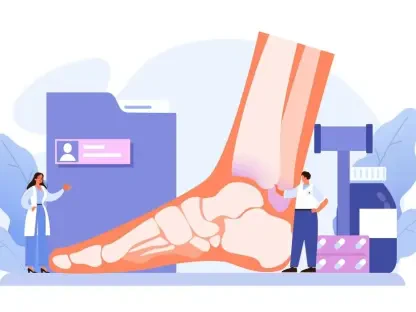Health data interoperability is a critical aspect of patient-centered care, allowing healthcare providers across the continuum to access and share vital patient information. Defined by HIMSS as the ability of diverse information systems, devices, and applications to access, exchange, integrate, and cooperatively use data efficiently within and across various boundaries, this capability ensures the timely and seamless portability of information, aiming to optimize the health of individuals and populations globally.
Improved Care Coordination
Enhancing Clinical Decision Support
One of the primary benefits of health data interoperability is the significant improvement in care coordination, which is particularly essential given the increasing prevalence of chronic diseases. Interoperable health information exchange (HIE) networks allow healthcare providers to access comprehensive, up-to-date information from disparate members of a patient’s care team. This capability enhances clinical decision support, aids in developing more accurate treatment plans, and ensures seamless care transitions. The ability to access detailed and current patient data enables clinicians to make well-informed decisions based on a complete picture of the patient’s health, avoiding potential gaps in care and improving outcomes.
Furthermore, the real-time access to patient information made possible by interoperability fosters better collaboration among healthcare providers. This collaboration is particularly crucial in managing chronic diseases, where multiple specialists and general practitioners might be involved in a patient’s care. With interoperability, each member of the care team can see the contributions and plans suggested by others, leading to a unified approach to treatment. This reduces the risk of conflicting treatments and helps in creating a more cohesive and holistic treatment plan that is aligned with the patient’s health goals and needs.
Seamless Care Transitions
Seamless transitions of care are critical when a patient moves between different healthcare settings, such as from a hospital to a primary care provider or a specialist. For instance, when a patient is discharged from a hospital, an HIE network can electronically transfer discharge summaries, medication lists, and follow-up instructions to the relevant healthcare providers. This minimizes errors such as missed follow-ups or medication conflicts, hence aiding patients in adhering to treatment plans for optimal outcomes. Ensuring that all information is accurately and promptly shared during care transitions can prevent complications that might arise from incomplete or delayed data transfer.
Moreover, interoperability’s role in facilitating smooth care transitions extends beyond the transfer of information. It also enables continuous monitoring and follow-up care. For instance, primary care providers receiving real-time updates on a patient’s ongoing treatments and progress can proactively address issues and adjust treatments as necessary. This proactive management helps in maintaining continuity of care, reduces the risk of rehospitalization, and supports the goal of achieving sustained health improvements for the patient.
Enhanced Patient Safety
Mitigating Adverse Drug Interactions
Interoperability plays a substantial role in improving patient safety. Access to a patient’s complete medical history, which includes details about allergies, medications, and prior diagnoses, helps mitigate adverse drug interactions and clinical errors. For example, a study cited in the Journal of the American Medical Informatics Association highlights that HIE participation can identify high-risk medication use, which clinicians may otherwise miss without clinical data exchange. This level of access ensures that clinicians are aware of all medications a patient is taking, reducing the potential for harmful interactions and allowing for safer prescription practices.
Additionally, real-time access to a patient’s medication history can provide critical safeguards against errors, such as double-dosing or prescribing medications that the patient has previously experienced adverse reactions to. This comprehensive view not only enhances medication safety but also builds trust between patients and providers, as patients feel assured that their care team has all the necessary information to manage their health safely.
Reducing Diagnostic Delays
Another significant safety benefit of interoperability is its ability to reduce diagnostic delays by providing instant access to previously conducted tests and imaging studies. This availability ensures that specialists can quickly diagnose and treat patients, thereby reducing risks associated with delayed treatments. For example, if a patient visits an emergency department and has already undergone imaging or lab tests at another facility, the immediate access to these results can expedite diagnosis and treatment decisions, eliminating the need for repeat tests and avoiding unnecessary exposure to radiation or other potential harms.
Moreover, prompt access to historical diagnostic information allows for better-informed clinical decisions. Clinicians can avoid redundant testing, quickly reference past test results for comparison, and leverage this information to deliver targeted and effective treatments. This efficiency not only accelerates the diagnostic process but also ensures that patients receive the most appropriate and timely care, ultimately enhancing their overall safety and well-being.
Better Patient Experience
Reducing Repetitive Tasks
Health data interoperability significantly enhances the patient experience by reducing the repetitive tasks associated with providing medical history during every visit. When healthcare providers have access to longitudinal health records, patients are relieved from the burden of recounting detailed medical information, such as past treatments, current medications, and allergies, at each appointment. This not only saves time but also reduces the risk of errors or omissions that may occur when patients are required to verbalize their medical history repeatedly.
Furthermore, the streamlined process enabled by interoperability allows for more efficient consultations, as clinicians can readily access and review a patient’s comprehensive health record before and during the visit. This ensures that the focus remains on addressing the patient’s current health concerns, leading to a more personalized and effective care experience. Patients appreciate the ability to engage in more meaningful and productive discussions with their healthcare providers when the administrative aspects are minimized.
Preventing Duplicate Testing
In addition to reducing repetitive tasks, interoperability helps prevent duplicate testing, which can save patients from both the financial burden and potential risks associated with unnecessary procedures. For instance, if a patient’s diagnostic imaging results are readily accessible to all healthcare providers, a new doctor can simply review the existing scans instead of ordering additional tests, thereby alleviating the patient’s anxiety about invasive procedures and financial challenges. This access to shared data promotes a more cost-effective approach to healthcare, as it curtails the waste of resources on redundant diagnostics.
Moreover, avoiding duplicate tests also protects patients from unnecessary exposure to procedures that might carry risks. For example, repeated imaging scans like X-rays or CT scans can increase a patient’s exposure to radiation over time, posing potential health risks. By ensuring that all involved providers have access to a patient’s existing test results, interoperability safeguards patients from these unnecessary and harmful exposures, ultimately contributing to a safer and more comfortable healthcare experience.
Faster Emergency Response
Real-Time Data Exchange
The importance of real-time data exchange in emergency care cannot be overstated, as every second can be crucial. Interoperability empowers providers with immediate access to critical patient information, which supports timely and accurate clinical decision-making. A study found that the availability of external health data is associated with a reduced risk of code blue events in emergency departments. Depending on the patient’s age and acuity level, the presence of outside data can reduce code blue event risks by 34% to 63%. Immediate access to detailed patient records enables ER physicians to quickly assess the patient’s condition, identify underlying health issues, and initiate appropriate treatments without delay.
Additionally, having comprehensive patient data at their fingertips allows emergency care providers to avoid redundant or potentially hazardous interventions. For instance, knowing a patient’s medication history or allergies can prevent adverse reactions to emergency treatments. This real-time information is critical in high-stakes situations where swift and accurate decisions can make a difference between life and death. The integration of interoperability in emergency care settings ensures that patient information flows seamlessly, enhancing the overall quality and efficiency of care delivered during emergencies.
Streamlining Patient Intake
Real-time health data exchange is equally crucial in streamlining patient intake processes. Examples such as Michigan’s state-designated HIE project illustrate how real-time health data exchange between emergency medical services (EMS) and hospitals can streamline patient intake and expedite clinical decision-making. The seamless transmission of vital signs and treatments administered by EMS enhances the coordination between EMS and emergency department teams. By receiving patient information en route, ER staff can prepare and prioritize resources according to the patient’s needs, ensuring a more efficient and effective intake process.
This capability not only accelerates patient triage but also supports better continuity of care. As EMS teams provide detailed data on pre-hospital interventions and patient status, ER clinicians can seamlessly continue the treatment without needing to start from scratch. This coordination minimizes delays, reduces patient wait times, and improves overall patient outcomes by ensuring that critical information is integrated into the care process immediately upon arrival. The streamlined approach facilitated by interoperability is pivotal in transforming emergency response and care efficiency.
Empowered Patients
Access to Health Information
Health data interoperability also plays a key role in empowering patients by fostering engagement. The integration of real-time data from electronic health records (EHRs) into patient portal applications allows individuals to access vital health information such as clinical notes, lab results, and immunization records. This accessibility promotes transparency and encourages patients to take an active role in managing their health. By having immediate access to their medical information, patients can better understand their health status, make more informed decisions, and actively participate in their care plans alongside their healthcare providers.
Moreover, patient portals often include features that allow patients to communicate directly with their healthcare teams, schedule appointments, and request prescription refills, further enhancing convenience and engagement. This level of involvement fosters a collaborative relationship between patients and providers, where patients feel more in control of their health journey. The empowerment derived from access to their health data helps patients become more proactive in managing chronic conditions, adhering to treatment plans, and maintaining overall wellness.
Enhancing Patient Engagement
Health data interoperability is vital for patient-centered care, enabling healthcare providers to access and share essential patient information seamlessly across various platforms. HIMSS defines interoperability as the ability of different information systems, devices, and applications to access, exchange, integrate, and use data efficiently within and across organizational boundaries. This capability ensures the timely and smooth portability of information, which is crucial for optimizing the health of individuals and populations worldwide. By facilitating the flow of health information, interoperability enhances diagnostic accuracy, treatment effectiveness, and overall care coordination. It also empowers patients by providing them with access to their health records, fostering better engagement and management of their health conditions. Overall, health data interoperability is a cornerstone of modern healthcare, aiming to achieve better health outcomes globally through improved information sharing and collaboration.









